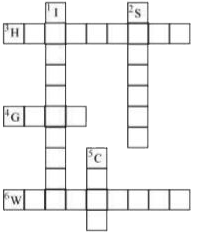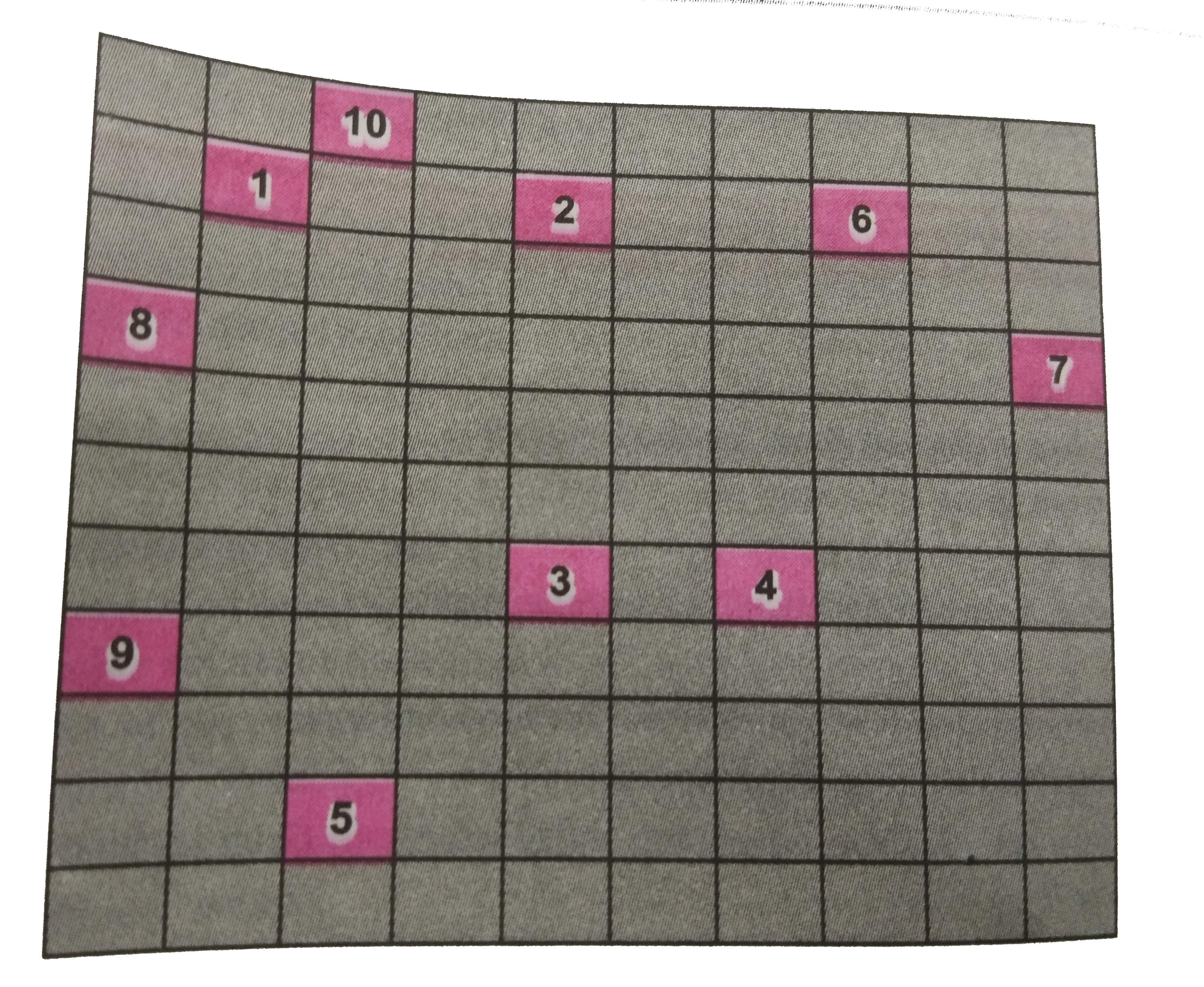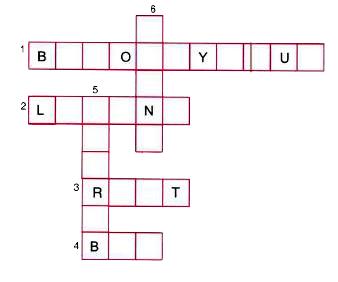
Down
1. Manure prepared with the help of earthworms
3. Oil-yielding plant
5. Undesirable plant in crop field
Across
2. Organic matter obtained from decomposition of plant and animal waste.
4. A micronutrient
6. Common fungal disease of wheat
Down: 1. Vermicompost 3. Sunflower 5.Weed
Across : 2. Manure 4.Boron 6. Rust
Topper's Solved these Questions
- BOOK - BHARATI BHAWAN (ENGLISH)CHAPTER - FOOD RESOURCES : PLANTSEXERCISE - D. Long-Answer Questions3videos
FOOD RESOURCES : PLANTS
- BOOK - BHARATI BHAWAN (ENGLISH)CHAPTER - FOOD RESOURCES : ANIMALS EXERCISE - LONG ANSWER13videos
FOOD RESOURCES : ANIMALS
- BOOK - BHARATI BHAWAN (ENGLISH)CHAPTER - FOOD RESOURCES PLANTS EXERCISE - Long Answer Questions6videos
FOOD RESOURCES PLANTS
Similar Questions
Complete the following word puzzle with the help of clues given below.
Down
1. Providing water to the crops.
2. Keeping crop grains for a long time under proper conditions
5. Certain plants of the same kind grown on a large scale.
Across
3. A machine used for cutting the matured crop.
4. A rabi crop that is also one of the pulses.
6. A process of separating the grain from chaff.
 View Solution
View SolutionComplete the following word puzzle with the help of clues given below.
Down
1. Providing water to the crops.
2. Keeping crop grains for a long time under proper conditions
5. Certain plants of the same kind grown on a large scale.
Across
3. A machine used for cutting the matured crop.
4. A rabi crop that is also one of the pulses.
6. A process of separating the grain from chaff.
 View Solution
View Solution
Knowledge Check
- Question 1 - Select One
Identify the correct match .
1. Stratification : Vertical distribution of different species occupying different levels .
2. Secondary productivity : Amount of biomass or organic matter produced per unit area over a time period by plant during photosynthesis .
3. Primary productivity : Rate of formation of new organic matter by consumers .
4 Decomposition : Break down complex organic matter into inorganic substances like carbon dioxide , water and nutrientsA1 and 3B2 and 4C1 and 4D2 and 3
Complete the crossword puzzle figure

Across
1. Oil yielding plant (9)
3. Crop grown in winter season (4)
5.Fixed by Rhizobium (8)
9.Common honey bee(4)
Downward
2. Animal feed (6)
4.A micronutrient (5)
6. Unwanted plant in crop fields (4)
7. An exotic breed of chicken (7)
8. Bottom feeders in fish pond (7)
10. A marine fish (4)View SolutionComplete the crossword puzzle (Fig.)

Across
1. Oil yielding plant (9)
2. Crop grown in winter season (4)
5. Fixed by Rhizobium (8)
9. Common honey bee (4)
Downward
2. Animal feed (6)
4. A micronutrient (5)
6. Unwanted plant in crop fields (4)
7. An exotic breed of chicken (7)
8. Bottom feeders in fish pond (7)
10. A marine fish (4)View SolutionComplete the crossword using the clues given below.
Clues across :
1. Plant that bears buds in leaves for propagation.
2. The flattened green part of leaf.
3. Underground plant part.
4. Structure that develops into flower.
Clues down :
5. The central big vein of a leaf.
6. A modification seen in cactus.
 View Solution
View SolutionIdentify the correct match .
1. Stratification : Vertical distribution of different species occupying different levels .
2. Secondary productivity : Amount of biomass or organic matter produced per unit area over a time period by plant during photosynthesis .
3. Primary productivity : Rate of formation of new organic matter by consumers .
4 Decomposition : Break down complex organic matter into inorganic substances like carbon dioxide , water and nutrientsView SolutionFirst read a passage and then answer the questions following that passage.
Soil scientists have shown that the soil teems with millions of living things, many of them useful, others harmful. The living things which are useful include earthworms and various kinds of bacteria. Earthworms loosen the soil and so enable air and water to enter it. Bacteria, which are microscopic living things break down dead plants and animals and make humus, or take nitrogen from the air and change it into substances that plants use. The living things that do harm include other bacteria and fungi which cause diseases. Other harmful things are pests such as wire worms which feed on the roots of grass and other plants. While the farmer can usually keep weeds in check by careful cultivation, this alone may not protect his crops from insects, pests and diseases. Nowadays, however, he is much better able to control these enemies. He may plant. specially resistant types of seeds or he may keep the pests and diseases in check with chemicals. With better seeds farmers have been able to increase their crop yield . They can grow crops that ripen more quickly and have a stronger resistance to disease, frost or drought.
Scientists who study soil believe thatView SolutionFirst read a passage and then answer the questions following that passage.
Soil scientists have shown that the soil teems with millions of living things, many of them useful, others harmful. The living things which are useful include earthworms and various kinds of bacteria. Earthworms loosen the soil and so enable air and water to enter it. Bacteria, which are microscopic living things break down dead plants and animals and make humus, or take nitrogen from the air and change it into substances that plants use. The living things that do harm include other bacteria and fungi which cause diseases. Other harmful things are pests such as wire worms which feed on the roots of grass and other plants. While the farmer can usually keep weeds in check by careful cultivation, this alone may not protect his crops from insects, pests and diseases. Nowadays, however, he is much better able to control these enemies. He may plant. specially resistant types of seeds or he may keep the pests and diseases in check with chemicals. With better seeds farmers have been able to increase their crop yield . They can grow crops that ripen more quickly and have a stronger resistance to disease, frost or drought.
The living things that do harmView SolutionFirst read a passage and then answer the questions following that passage.
Soil scientists have shown that the soil teems with millions of living things, many of them useful, others harmful. The living things which are useful include earthworms and various kinds of bacteria. Earthworms loosen the soil and so enable air and water to enter it. Bacteria, which are microscopic living things break down dead plants and animals and make humus, or take nitrogen from the air and change it into substances that plants use. The living things that do harm include other bacteria and fungi which cause diseases. Other harmful things are pests such as wire worms which feed on the roots of grass and other plants. While the farmer can usually keep weeds in check by careful cultivation, this alone may not protect his crops from insects, pests and diseases. Nowadays, however, he is much better able to control these enemies. He may plant. specially resistant types of seeds or he may keep the pests and diseases in check with chemicals. With better seeds farmers have been able to increase their crop yield . They can grow crops that ripen more quickly and have a stronger resistance to disease, frost or drought.
Farmers are always carefulView Solution

